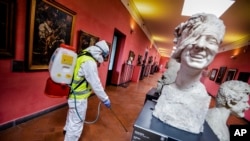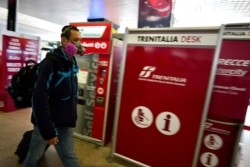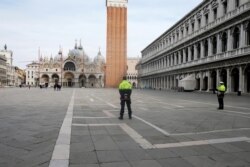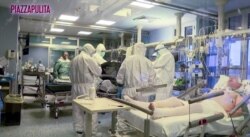The Italian government may turn to the army to buttress the police in enforcing a dramatic "stay-at-home" order imposed Monday by Prime Minister Giuseppe Conte to try to retard the spread of the coronavirus contagion.
Announcing the decision in a televised address to the nation, Conte said limiting the movement of people throughout the country was absolutely essential. “I am going to sign a decree that can be summarized as follows: I stay at home,” Conte said. “Travel must be avoided across the entire peninsula unless it is justified by professional reasons, by cases of need or for health reasons.”
He added, “We know how difficult it is to change our habits but there is no time.” He said, “Our habits must be changed now. Today is our moment of responsibility. We cannot let our guard down ... Everyone needs to play their part.”
His move extends a quarantine, set up Sunday, which covered 16 million Italians living in the region of Lombardy and more than a dozen nearby provinces in the north of the country, where the virus first appeared in Italy in the village of Codogno on February 20.
Since then, the number of confirmed cases has soared to 9,172 with 463 of those infected succumbing to the virus. There’s also rising concern in Italy about the death-to-cases ratio, which is running at 5 percent, much higher than other countries struggling with coronavirus.
Italian officials acknowledge they do expect the drastic order to spark some civil unrest, but they believe a sense of patriotism — as well as fear of the deadly virus — will persuade most Italians to observe the restrictions on their movements. On Sunday, inmates rioted at 27 prisons in protest over the suspension of visits from family and friends.
Italians in normally bustling cities like Rome and Milan woke Tuesday to empty streets and a surreal quiet. “Citizens must know that this is not about changing their lifestyle just for one or two weeks,” warned Stefania Salmaso the head of the Italian national center for epidemiology. She warned the restrictions “will likely have to be kept for a long time” as the peak of the contagion is not expected in the north of the country to be reached until mid-April and in the south several weeks later, according to disease modelers and epidemiologists.
Some think the order does not go far enough and that the government has introduced a fatal flaw by allowing Italians to move around, if they "self-certify" by signing a document supplied by the police stating they have to travel for work or for health reasons or because of an emergency.
Virman Cusenza, editor of the influential Rome-based newspaper Il Messaggero, criticized the order, saying relying on self-responsibility is a mistake.“
The risk of exposing entire communities, national public health, to potential contagion is very high,” he said in an open letter to Conte. He also criticized the penalties for abuse — a fine of 230 euros ($262) and a possible jail term of three months — as too weak. “This is not the dissuasive way for those who transgress. We must ensure a real tightening in the name of public health, not palliatives. In short, block everything. But really stop,” he said.
Compliance checks will focus on highways and railway stations with the Carabinieri and traffic police questioning people and asking them about their "self-declarations." Ordinary roads will mainly be checked by municipal and other local police forces. But some Italians question how the no-movement measure can be seriously enforced on 60 million people — and they worry whether the move, the most sweeping travel restrictions imposed since the Second World War, will be sufficient to slow the transmission of the virus.
Politicians in southern regions of the country say they expect to see an abrupt jump in their infections rate because of what they describe as a bungled introduction of a quarantine Sunday on much of the north country on Sunday, which prompted an exodus to the south of thousands of people from the northern regions of Lombardy and Veneto.
Under the new order, all open-air gatherings of people are banned, as are sporting events and sporting facilities, including swimming pools, spas, sport halls and ski resorts, which have been closed. All museums and cultural venues, along with nightclubs, cinemas, theaters and casinos have been ordered shut. Restaurants and bars are allowed to stay open between 6 a.m. and 6 p.m., but diners must be kept at least one meter apart. And the ban extends an earlier closure of all schools and universities to April 3.“
People are starting to understand the gravity,” said Andrea Sterpino, the owner of the bar and restaurant San Rocco in the Lazio village of Celleno. “People are very fearful of the virus,” he added.
The nationwide lockdown, the most radical measure taken by a European country so far to try to slow the spread of the coronavirus, has left thousands of foreign tourists and visitors in Italy in a quandary. Many airlines have suspended flights to and from Italy until early April, including British Airways, Ryanair and Delta.
Italian officials say the new measure should show some results in terms of a declining number of cases within two weeks, and they look at China as the model for their action. While the number of cases continues to spiral in Italy, China reported only 17 deaths and 19 new cases Monday, the lowest figure since January.
Neighboring European countries are closely watching Italy’s dramatic move, fearing that they too might have to follow suit. Czech Prime Minister Andrej Babis has urged Italy to ban its citizens from leaving the country.
Italian critical care specialists have issued a stark warning to their colleagues in other European states, saying they will need to set aside a large number of intensive-care beds for the virus when it starts surging in their countries.
In a letter to the European Society of Intensive Care Medicine, they said that up to 10 percent of all those infected need intensive care, and acknowledged that hospitals in the north of Italy had become overwhelmed. “We wish to convey a strong message, they said. “Get ready! Increase your total ICU capacity. Identify early hospitals that can manage the initial surge in a safe way. Get ready to prepare ICU areas for COVID-19 patients — in every hospital if necessary.”
In the north of Italy, doctors say they are having to make heart-breaking life-death decisions about who to treat because of limited resources.
A critical care doctor working on coronavirus cases in northern Italy says the virus is nothing like the flu. In a post he shared on Facebook, Dr. Daniele Macchini says the disease is a “tsunami that has swept us all,” and describes how medical staff are working non-stop at his hospital in the northern town of Bergamo. “The situation is now nothing short of dramatic ... The war has literally exploded and the battles are uninterrupted day and night. Let's stop saying it's a bad flu,” he wrote.
He warned the virus doesn’t only affect the elderly and that plenty of younger people “end up intubated in intensive care.” He criticized people who say on social media they are not afraid and complain “because their normal lifestyle habits are "temporarily" in crisis — all while an epidemiological disaster is taking place.








